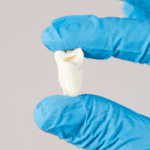Dental fillings are the first thing that comes to mind when you think about what treatment options you can do to restore your damaged or decayed teeth. But, there are other options to consider, like dental inlays and onlays. Let’s go over what dental inlays are and when they become the best option for restoring your teeth.
What Is a Dental Inlay?
Dental inlays are pre-molded fillings fitted into tooth grooves to restore cavities found in the center. Gold and porcelain are durable materials often used to make them.
Dental Inlay vs. Dental Onlay
The main difference between inlays and onlays is that the latter is a more extensive dental restoration treatment, covering larger areas than inlay procedures. When done, dentists drill out the cavities and remove decayed areas of the teeth before filling them in with onlays.
Another difference is that onlays cover cavities found on the cusps — the outer edges or tips of the teeth. On the other hand, inlays on teeth cover cavities in the center.
Dental Inlay vs. Filling
Many people think that dentists interchangeably use inlay and filling, but they don’t. Fillings are used for smaller cavities, and their process is more straightforward. Amalgams or composite material fill in the decayed parts of the teeth. Both of these don’t need fabrication, which allows the dentist to finish the procedure in just one visit.
When Does Dental Inlay Become the Best Option?
Dental inlays become your best option when half of your tooth decays, is chipped, or is so severely damaged that dental filling won’t do any good. Inlays are also the best option for strengthening damaged teeth as traditional fillings can significantly weaken them. Inlays are bonded to teeth and create stability.
Dentists and dental hygienists may recommend inlays when the condition of your teeth matches the following criteria:
- The decay or damage doesn’t affect the cusps of teeth.
- The damage is extensive enough that filling might weaken the remaining structure.
- The injury level doesn’t call for tooth removal or dental crown procedure.
What Happens During an Inlay Procedure?
Here’s what to expect during an inlay procedure:
1. Tooth Cleaning and Preparation
This step includes cleaning the teeth and other procedures, such as drilling and removing the decay.
2. Tooth Impression
During this step, dentists create molds or impressions using dental putty positioned over the prepared teeth. The molds or impressions are sent to dental laboratories for fabrication.
3. Temporary Restoration Placement
While waiting for inlay fabrication, dentists place a temporary restoration to protect teeth from further damage.
4. Cleaning and Preparation
Once the fabrication is complete, dentists clean and prepare the teeth again for fitting and bonding.
5. Fitting and Bonding
Dentists make sure that inlays perfectly fit before they bond them to the teeth using dental cement.
Post-procedure Care for Inlays
Within the first 48 hours after your inlay procedure, avoid food and drink with extremely hot or cold temperatures and those that are sticky and hard. Eat soft and healthy foods for the first few days following the procedure. These help dental inlays last longer.
You may feel sore or numb after the procedure, but once these feelings subside, immediately get back to your daily dental health routine. Brush twice a day and floss at least once to prevent bacteria from damaging your inlays and natural teeth.
Advantages of Dental Inlays
Inlays are good options for restoring teeth because:
- They are strong and durable – Inlays are more robust and durable compared to fillings. When properly applied, they can strengthen teeth by up to 75%.
- They give natural-looking results – Porcelain, one of the materials used for inlays, gives a natural-looking result. It can be shade-matched to blend in with teeth seamlessly. With fabrication, it can easily mimic the sheen of enamel. It is also resistant to stains; no need to worry about discoloration over time.
- They don’t expand – Amalgams expand as temperatures change, which causes cracks where food particles and plaque accumulate. Inlays remain in their original shape and size and provide a much more stable solution.
- They are low-maintenance – The home care needed for inlays is no different from your natural teeth. As long as you practice proper dental hygiene and visit dentists regularly, your inlays will last long.
- They are a conservative treatment – Inlays are a conservative restoration option, unlike dental crowns. With inlay procedures, dentists have the option to preserve more of the natural structure of teeth.
How Long Do Inlays Last?
On average, dental inlays last for a decade. In some cases, they last for only five years, and some up to 30 years. There are also cases wherein inlays last for only a couple of years. Their life expectancies depend on a person’s dental hygiene and habits. Inlays are damaged sooner when you don’t brush and regularly floss or grind and clench your teeth.
Let Advanced Dental Group Help
If you have decayed or damaged teeth that need dental inlays, don’t wait for the condition to worsen before seeking help from a dentist.
At Advanced Dental Group, we’ve partnered with dentists in the U.S. Call us today, and we’ll connect you to the best ones in your area.





